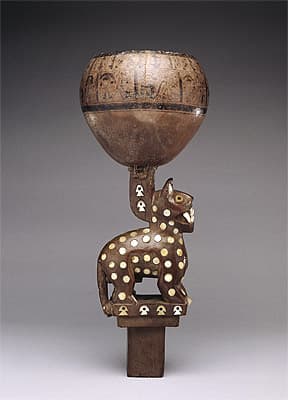
CHIMÚ culture North 1100 – 1470 AD
Ceremonial cup 1100-1470 AD wood, gourd, mother-of-pearl, lapis lazuli, twine39.9 (h) x 16.7 (w) x 16.5 (d) cm Museo Larco, Lima Photograph: Museo Larco
This ceremonial cup is divided into two quite dissimilar sections. The bottom comprises a carved wooden jaguar resplendent with mother-of-pearl inlaid spots, teeth and ears. It stands on a small platform that is elevated by a further section or peg of plain wood. A pattern of inlaid vertical fish, with lapis lazuli eyes, decorates the platform and the carved section emanating from the back of the animal’s head.
Set on top, the gourd cup is attached to the lower section with twine. The vessel has been decorated using a burning technique known as pyrography, an ancient art that continues in Peru to this day.1 The imagery achieved through this method is very detailed in comparison with the inlay in the lower section.
In two registers—separated and surrounded by a series of thin and thick lines—nine panels display repeated representations of a human figure. He has a long tail, feet in the shape of birds’ heads, and is richly adorned with a crescent headdress and ear ornaments. The figure is accompanied by a smaller zoomorphic entity, seen in profile, which has feline fangs and monkey tail. In a separate panel, a similar small figure—this time with a forked tongue, claws and a tail with triangular finial, wearing a feline headdress—is accompanied by a large monkey. Images of birds and beetles also appear in the upper register.
Simeran Maxwell
1. Catalogue entry, Museo Larco website, http://www.museolarco.org/catalogo/ficha.php?id=18673, accessed on 30 July 2013.
This ceremonial cup is divided into two quite dissimilar sections. The bottom comprises a carved wooden jaguar resplendent with mother-of-pearl inlaid spots, teeth and ears. It stands on a small platform that is elevated by a further section or peg of plain wood. A pattern of inlaid vertical fish, with lapis lazuli eyes, decorates the platform and the carved section emanating from the back of the animal’s head.
Set on top, the gourd cup is attached to the lower section with twine. The vessel has been decorated using a burning technique known as pyrography, an ancient art that continues in Peru to this day.1 The imagery achieved through this method is very detailed in comparison with the inlay in the lower section.
In two registers—separated and surrounded by a series of thin and thick lines—nine panels display repeated representations of a human figure. He has a long tail, feet in the shape of birds’ heads, and is richly adorned with a crescent headdress and ear ornaments. The figure is accompanied by a smaller zoomorphic entity, seen in profile, which has feline fangs and monkey tail. In a separate panel, a similar small figure—this time with a forked tongue, claws and a tail with triangular finial, wearing a feline headdress—is accompanied by a large monkey. Images of birds and beetles also appear in the upper register.
Simeran Maxwell
1. Catalogue entry, Museo Larco website, http://www.museolarco.org/catalogo/ficha.php?id=18673, accessed on 30 July 2013.
This ceremonial cup is divided into two quite dissimilar sections. The bottom comprises a carved wooden jaguar resplendent with mother-of-pearl inlaid spots, teeth and ears. It stands on a small platform that is elevated by a further section or peg of plain wood. A pattern of inlaid vertical fish, with lapis lazuli eyes, decorates the platform and the carved section emanating from the back of the animal’s head.
Set on top, the gourd cup is attached to the lower section with twine. The vessel has been decorated using a burning technique known as pyrography, an ancient art that continues in Peru to this day.1 The imagery achieved through this method is very detailed in comparison with the inlay in the lower section.
In two registers—separated and surrounded by a series of thin and thick lines—nine panels display repeated representations of a human figure. He has a long tail, feet in the shape of birds’ heads, and is richly adorned with a crescent headdress and ear ornaments. The figure is accompanied by a smaller zoomorphic entity, seen in profile, which has feline fangs and monkey tail. In a separate panel, a similar small figure—this time with a forked tongue, claws and a tail with triangular finial, wearing a feline headdress—is accompanied by a large monkey. Images of birds and beetles also appear in the upper register.
Simeran Maxwell
1. Catalogue entry, Museo Larco website, http://www.museolarco.org/catalogo/ficha.php?id=18673, accessed on 30 July 2013.

